TOYOTA PRIUS 2016 4.G Owners Manual
Manufacturer: TOYOTA, Model Year: 2016, Model line: PRIUS, Model: TOYOTA PRIUS 2016 4.GPages: 800, PDF Size: 16.69 MB
Page 351 of 800
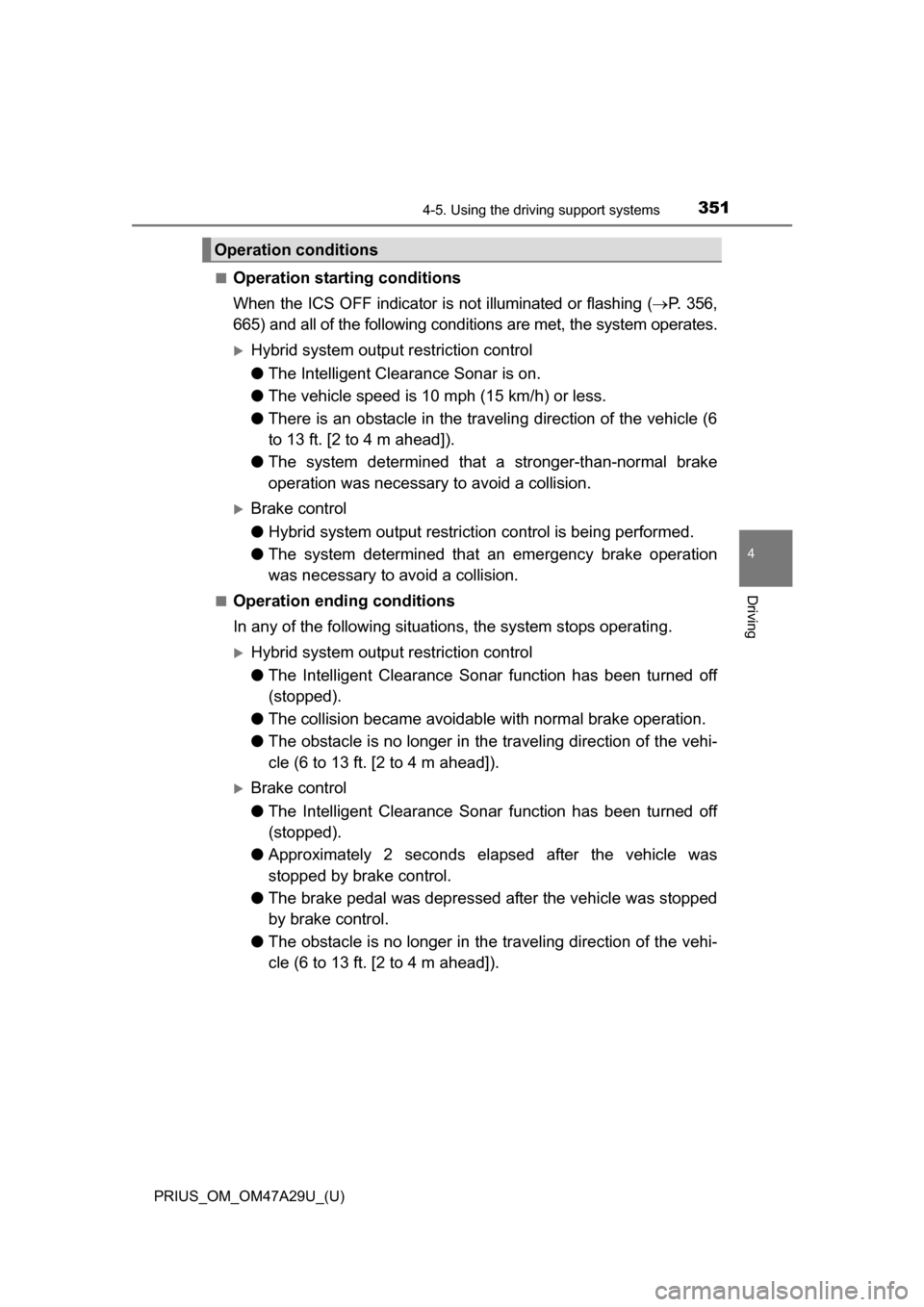
PRIUS_OM_OM47A29U_(U)
3514-5. Using the driving support systems
4
Driving
■Operation starting conditions
When the ICS OFF indi cator is not illuminated or flashing ( P. 356,
665) and all of the fo llowing conditions are met, the system operates.
Hybrid system output restriction control
● The Intelligent Clearance Sonar is on.
● The vehicle speed is 10 mph (15 km/h) or less.
● There is an obstacle in the traveling direction of the vehicle (6
to 13 ft. [2 to 4 m ahead]).
● The system determined that a stronger-than-normal brake
operation was necessar y to avoid a collision.
Brake control
●Hybrid system output restrict ion control is being performed.
● The system determined that an emergency brake operation
was necessary to avoid a collision.
■Operation ending conditions
In any of the following situations, the system stops operating.
Hybrid system output restriction control
● The Intelligent Clearance Sonar function has been turned off
(stopped).
● The collision became avoidable with normal brake operation.
● The obstacle is no longer in the traveling direction of the vehi-
cle (6 to 13 ft. [2 to 4 m ahead]).
Brake control
●The Intelligent Clearance Sonar function has been turned off
(stopped).
● Approximately 2 seconds elapsed after the vehicle was
stopped by brake control.
● The brake pedal was depressed after the vehicle was stopped
by brake control.
● The obstacle is no longer in the traveling direction of the vehi-
cle (6 to 13 ft. [2 to 4 m ahead]).
Operation conditions
Page 352 of 800
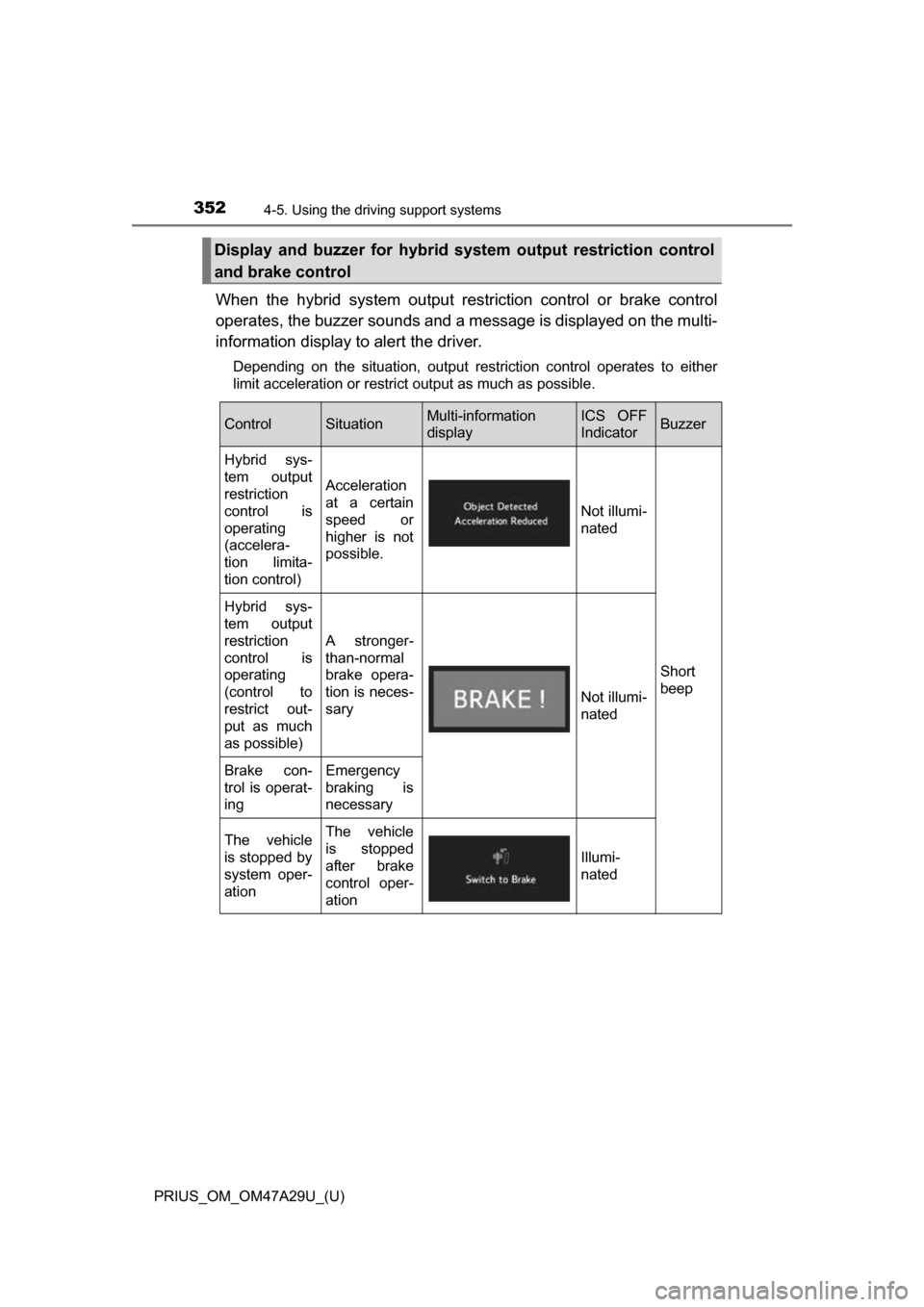
352
PRIUS_OM_OM47A29U_(U)
4-5. Using the driving support systems
When the hybrid system output restriction control or brake control
operates, the buzzer sounds and a message is displayed on the multi-
information display to alert the driver.
Depending on the situation, output restriction control operates to either
limit acceleration or restrict output as much as possible.
Display and buzzer for hybrid system output restriction control
and brake control
ControlSituationMulti-information
displayICS OFF
IndicatorBuzzer
Hybrid sys-
tem output
restriction
control is
operating
(accelera-
tion limita-
tion control)
Acceleration
at a certain
speed or
higher is not
possible.
Not illumi-
nated
Short
beep
Hybrid sys-
tem output
restriction
control is
operating
(control to
restrict out-
put as much
as possible)
A stronger-
than-normal
brake opera-
tion is neces-
sary
Not illumi-
nated
Brake con-
trol is operat-
ingEmergency
braking is
necessary
The vehicle
is stopped by
system oper-
ationThe vehicle
is stopped
after brake
control oper-
ation
Illumi-
nated
Page 353 of 800
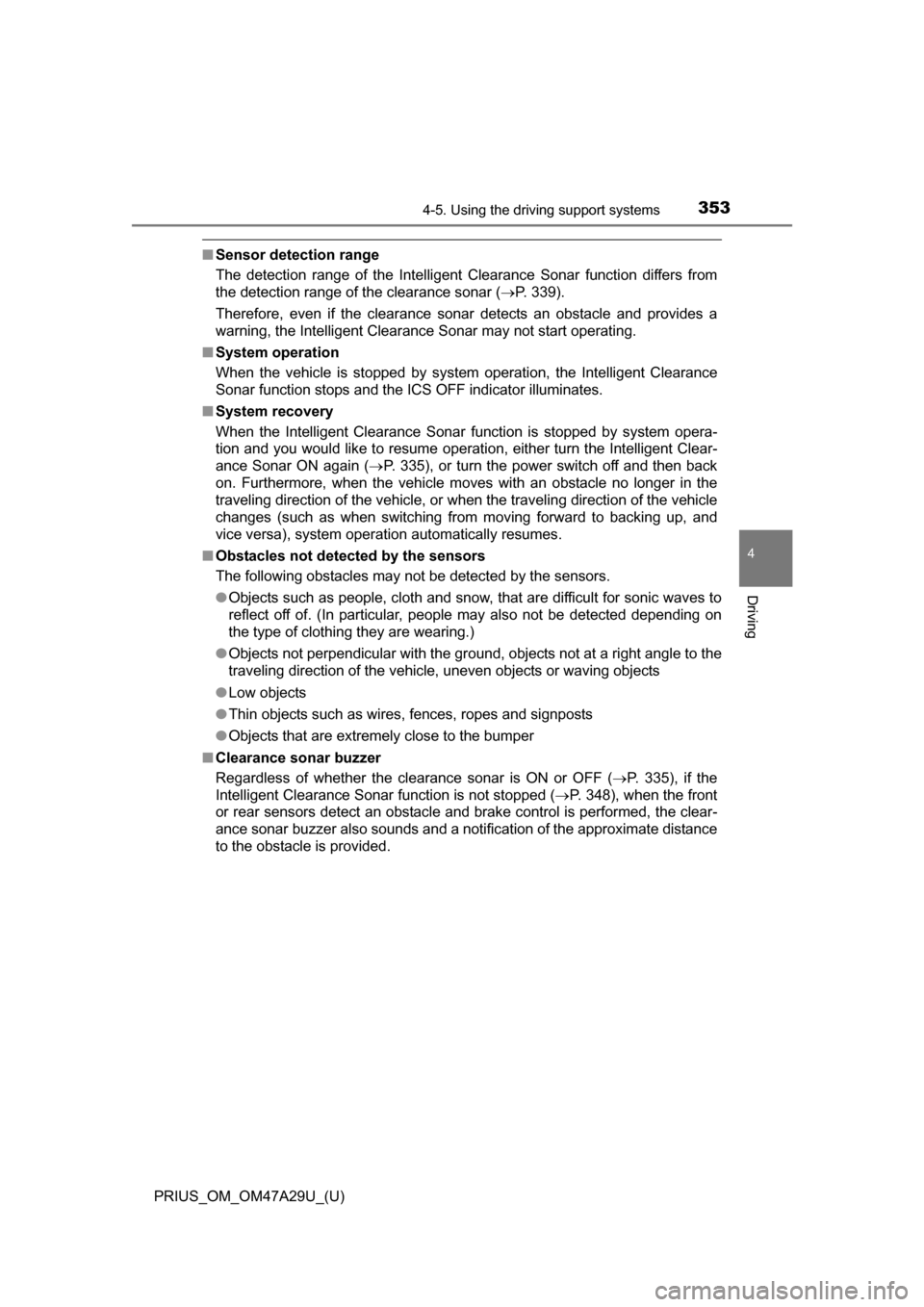
PRIUS_OM_OM47A29U_(U)
3534-5. Using the driving support systems
4
Driving
■Sensor detection range
The detection range of the Intelligent Clearance Sonar function differs from
the detection range of the clearance sonar ( P. 339).
Therefore, even if the clearance sonar detects an obstacle and provides a
warning, the Intelligent Clearance Sonar may not start operating.
■ System operation
When the vehicle is stopped by system operation, the Intelligent Clearance
Sonar function stops and the ICS OFF indicator illuminates.
■ System recovery
When the Intelligent Clearance Sonar function is stopped by system opera-
tion and you would like to resume operation, either turn the Intelligent Clear-
ance Sonar ON again ( P. 335), or turn the power switch off and then back
on. Furthermore, when the vehicle moves with an obstacle no longer in the
traveling direction of the vehicle, or when the traveling direction of the vehicle
changes (such as when switching from moving forward to backing up, and
vice versa), system operation automatically resumes.
■ Obstacles not detected by the sensors
The following obstacles may not be detected by the sensors.
●Objects such as people, cloth and snow, that are difficult for sonic waves to
reflect off of. (In particular, people may also not be detected depending on
the type of clothing they are wearing.)
● Objects not perpendicular with the ground, objects not at a right angle to the
traveling direction of the vehicle, uneven objects or waving objects
● Low objects
● Thin objects such as wires, fences, ropes and signposts
● Objects that are extremely close to the bumper
■ Clearance sonar buzzer
Regardless of whether the clearance sonar is ON or OFF ( P. 335), if the
Intelligent Clearance Sonar function is not stopped ( P. 348), when the front
or rear sensors detect an obstacle and brake control is performed, the clear-
ance sonar buzzer also sounds and a notification of the approximate distance
to the obstacle is provided.
Page 354 of 800

354
PRIUS_OM_OM47A29U_(U)
4-5. Using the driving support systems
■Situations when the system may opera te even though there is no possi-
bility of a collision
In the following situations, the system may operate even though there is no
possibility of a collision.
● Environmental influence
• The vehicle is driven toward a banner or flag, a low-hanging branch or a
boom barrier (such as those used at railroad crossings, toll gates and
parking lots).
• There is an obstacle on the shoulder of the road (when the vehicle is driven in a narrow tunnel, on a narrow bridge or on a narrow road)
• The vehicle is being parallel parked
• There is a rut or hole in the surface of the road
• When the vehicle is driven on a metal cover (grating), such as those used for drainage ditches
• The vehicle is driven on a steep slope
• The sensor is covered by water on a flooded road
● Influence from the weather
• Ice, snow, dirt, etc., has adhered to the sensor (if removed, the system
returns to normal)
• Heavy rain or water strikes the vehicle
• In severe weather such as fog, snow or a sand storm
● Influence from other sonic waves
• An ultrasonic wave source is nearby, such as the horn or clearance sonar
of another vehicle, a vehicle detector, a motorcycle engine or the air
brake of a large vehicle
• Electronic components (such as a backlit license plate (especially fluo-
rescent types), fog lights, a fender pole or a wireless antenna) are
installed near the sensors
• The vehicle is driven on a narrow
road
• The vehicle is driven on a gravel road or in an area with tall grass
Page 355 of 800
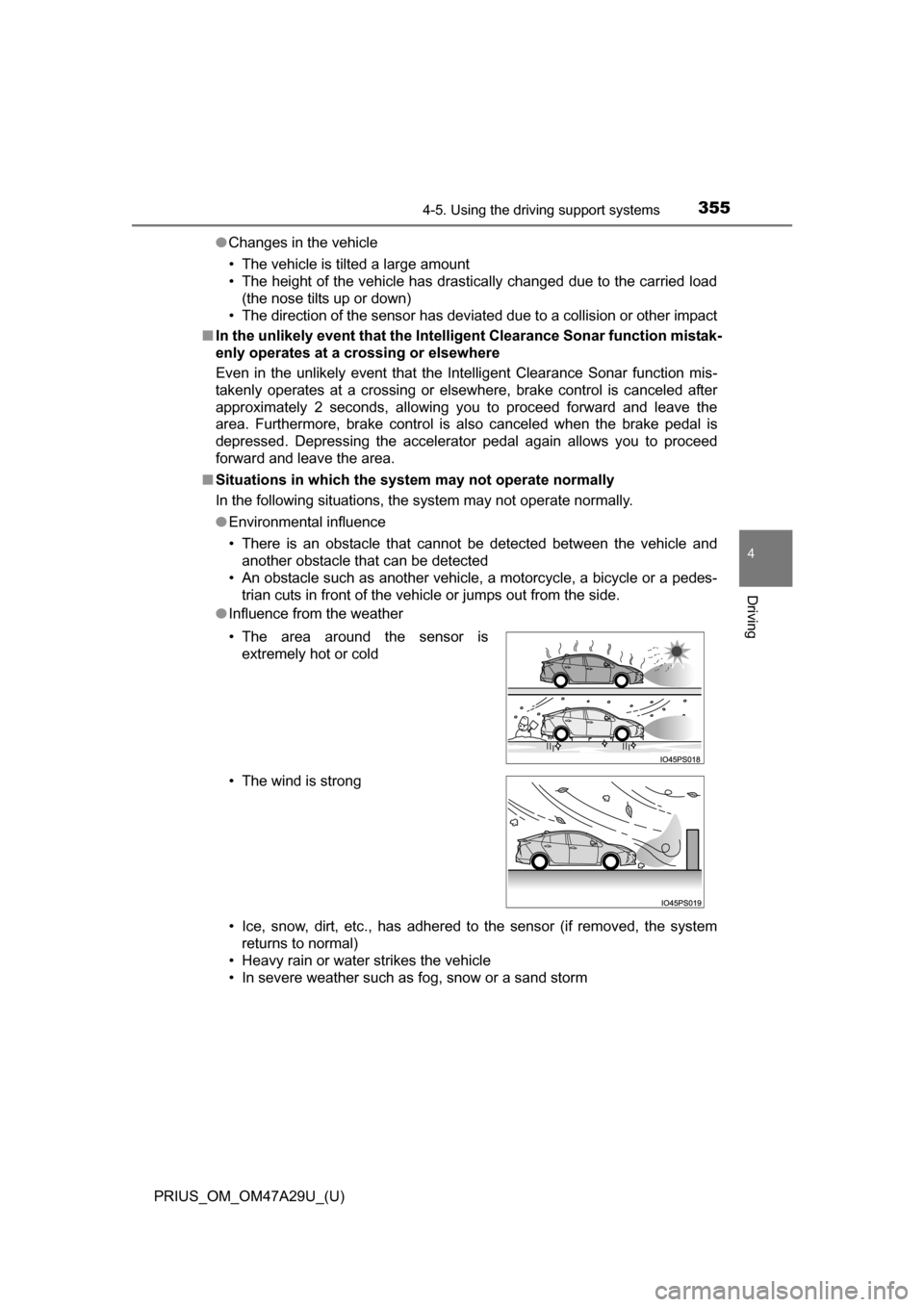
PRIUS_OM_OM47A29U_(U)
3554-5. Using the driving support systems
4
Driving
●Changes in the vehicle
• The vehicle is tilted a large amount
• The height of the vehicle has drastically changed due to the carried load
(the nose tilts up or down)
• The direction of the sensor has deviated due to a collision or other impact
■ In the unlikely event that the Intell igent Clearance Sonar function mistak-
enly operates at a crossing or elsewhere
Even in the unlikely event that the Intelligent Clearance Sonar function mis-
takenly operates at a crossing or elsewhere, brake control is canceled after
approximately 2 seconds, allowing you to proceed forward and leave the
area. Furthermore, brake control is also canceled when the brake pedal is
depressed. Depressing the accelerator pedal again allows you to proceed
forward and leave the area.
■ Situations in which the system may not operate normally
In the following situations, the system may not operate normally.
●Environmental influence
• There is an obstacle that cannot be detected between the vehicle and
another obstacle that can be detected
• An obstacle such as another vehicle, a motorcycle, a bicycle or a pedes-
trian cuts in front of the vehicle or jumps out from the side.
● Influence from the weather
• Ice, snow, dirt, etc., has adhered to the sensor (if removed, the system
returns to normal)
• Heavy rain or water strikes the vehicle
• In severe weather such as fog, snow or a sand storm • The area around the sensor is extremely hot or cold
• The wind is strong
Page 356 of 800
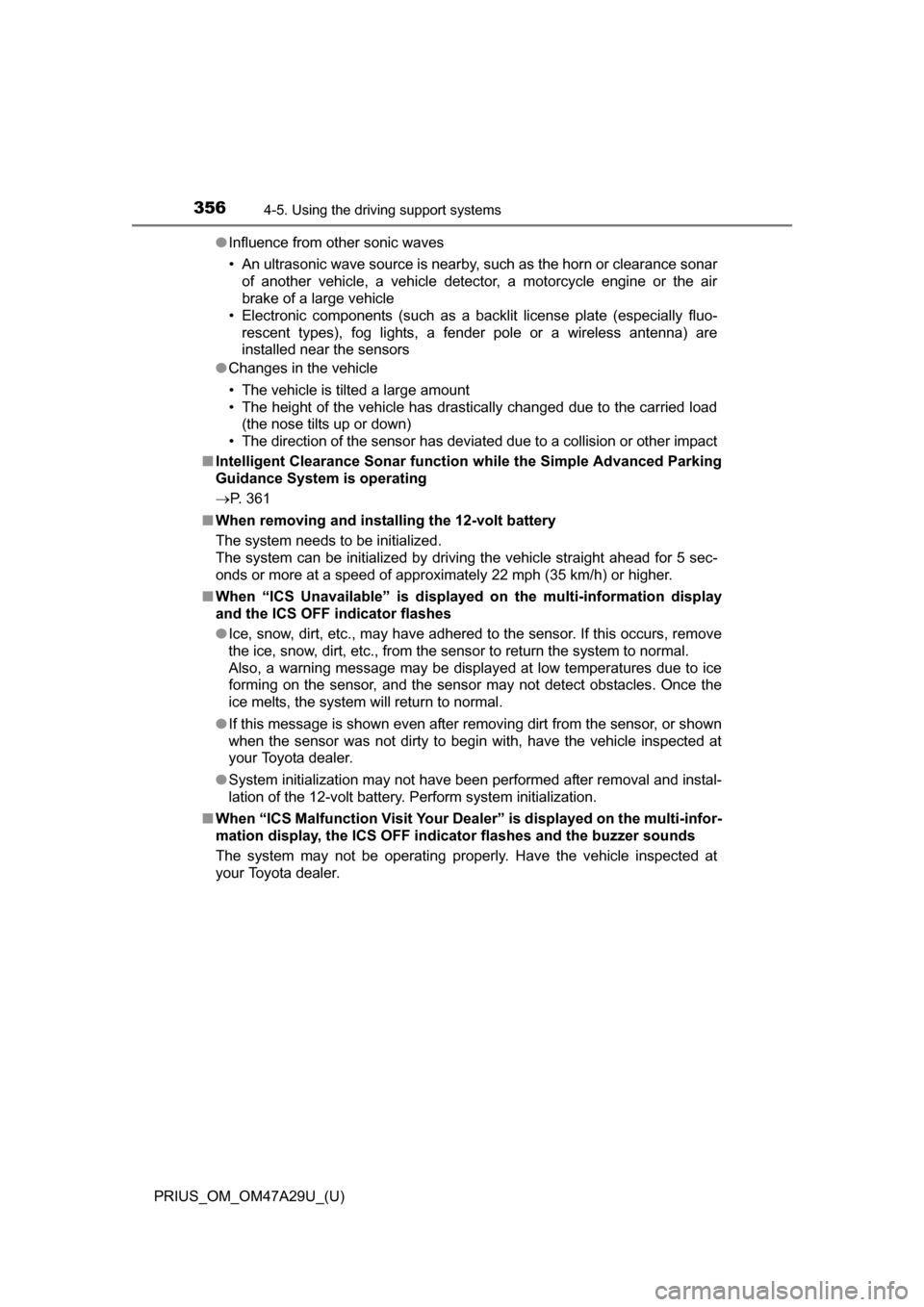
356
PRIUS_OM_OM47A29U_(U)
4-5. Using the driving support systems
●Influence from other sonic waves
• An ultrasonic wave source is nearby, such as the horn or clearance sonar
of another vehicle, a vehicle detector, a motorcycle engine or the air
brake of a large vehicle
• Electronic components (such as a backlit license plate (especially fluo- rescent types), fog lights, a fender pole or a wireless antenna) are
installed near the sensors
● Changes in the vehicle
• The vehicle is tilted a large amount
• The height of the vehicle has drastically changed due to the carried load
(the nose tilts up or down)
• The direction of the sensor has deviated due to a collision or other impact
■ Intelligent Clearance Sonar function while the Simple Advanced Parking
Guidance System is operating
P. 361
■ When removing and installing the 12-volt battery
The system needs to be initialized.
The system can be initialized by driving the vehicle straight ahead for 5 sec-
onds or more at a speed of approximately 22 mph (35 km/h) or higher.
■ When “ICS Unavailable” is displayed on the multi-information display
and the ICS OFF indicator flashes
● Ice, snow, dirt, etc., may have adhered to the sensor. If this occurs, remove
the ice, snow, dirt, etc., from the sensor to return the system to normal.
Also, a warning message may be displayed at low temperatures due to ice
forming on the sensor, and the sensor may not detect obstacles. Once the
ice melts, the system will return to normal.
● If this message is shown even after removing dirt from the sensor, or shown
when the sensor was not dirty to begin with, have the vehicle inspected at
your Toyota dealer.
● System initialization may not have been performed after removal and instal-
lation of the 12-volt battery. Perform system initialization.
■ When “ICS Malfunction Visit Your Deal er” is displayed on the multi-infor-
mation display, the ICS OFF indi cator flashes and the buzzer sounds
The system may not be operating properly. Have the vehicle inspected at
your Toyota dealer.
Page 357 of 800
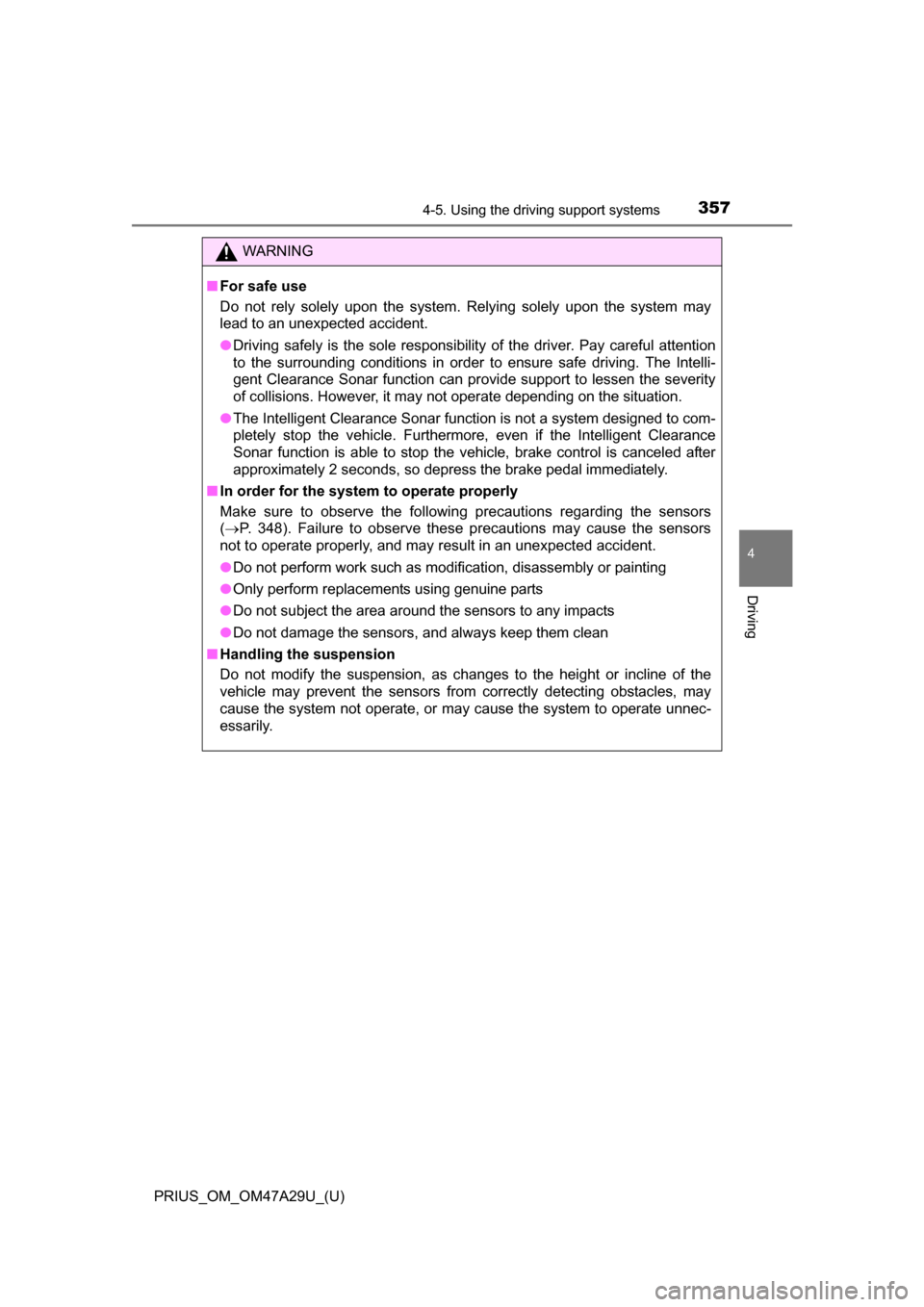
PRIUS_OM_OM47A29U_(U)
3574-5. Using the driving support systems
4
Driving
WARNING
■For safe use
Do not rely solely upon the system. Relying solely upon the system may
lead to an unexpected accident.
●Driving safely is the sole responsibility of the driver. Pay careful attention
to the surrounding conditions in order to ensure safe driving. The Intelli-
gent Clearance Sonar function can provide support to lessen the severity
of collisions. However, it may not operate depending on the situation.
● The Intelligent Clearance Sonar function is not a system designed to com-
pletely stop the vehicle. Furthermore, even if the Intelligent Clearance
Sonar function is able to stop the vehicle, brake control is canceled after
approximately 2 seconds, so depress the brake pedal immediately.
■ In order for the system to operate properly
Make sure to observe the following precautions regarding the sensors
( P. 348). Failure to observe these precautions may cause the sensors
not to operate properly, and may result in an unexpected accident.
● Do not perform work such as modification, disassembly or painting
● Only perform replacements using genuine parts
● Do not subject the area around the sensors to any impacts
● Do not damage the sensors, and always keep them clean
■ Handling the suspension
Do not modify the suspension, as changes to the height or incline of the
vehicle may prevent the sensors from correctly detecting obstacles, may
cause the system not operate, or may cause the system to operate unnec-
essarily.
Page 358 of 800
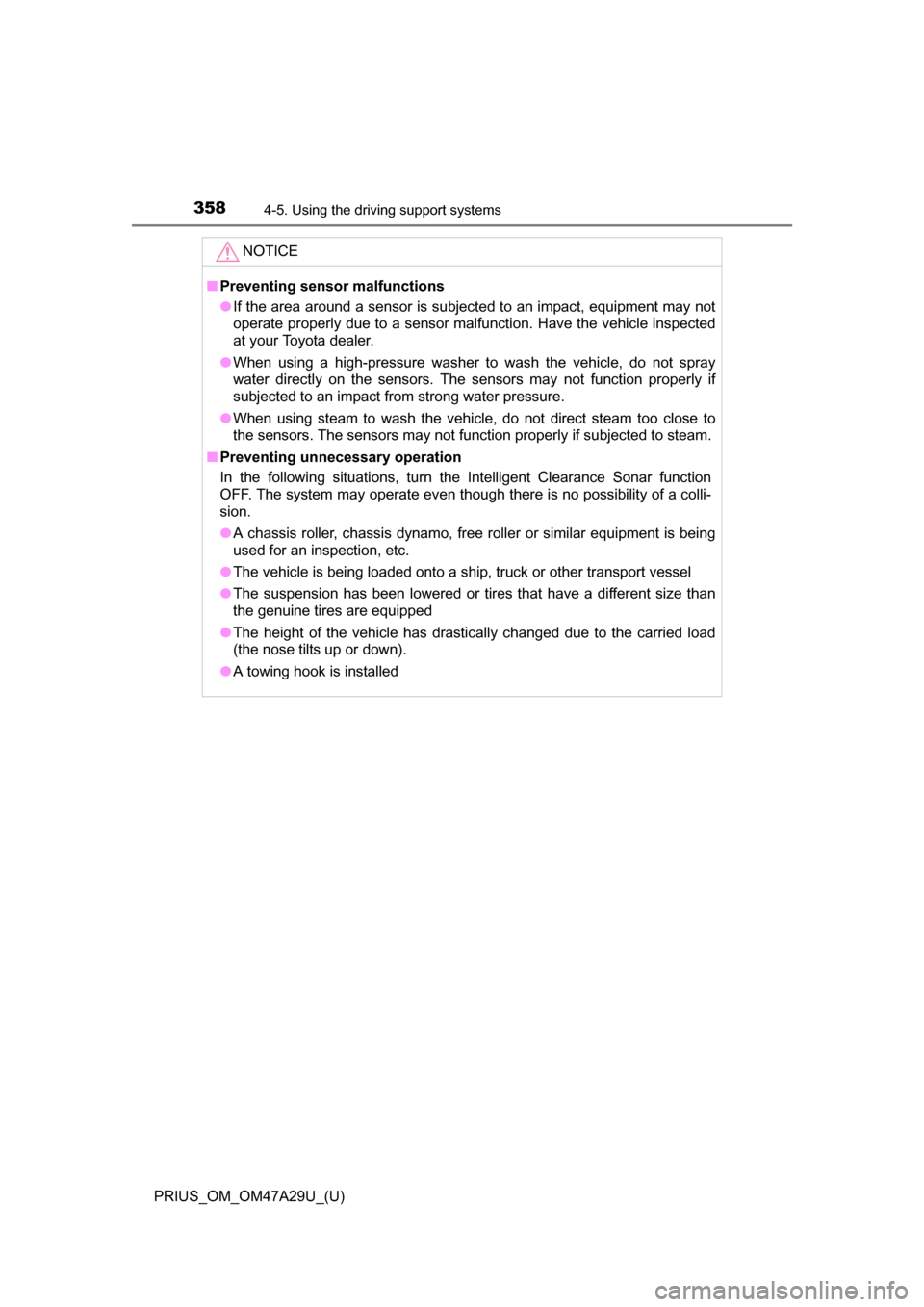
358
PRIUS_OM_OM47A29U_(U)
4-5. Using the driving support systems
NOTICE
■Preventing sensor malfunctions
●If the area around a sensor is subjected to an impact, equipment may not
operate properly due to a sensor malfunction. Have the vehicle inspected
at your Toyota dealer.
● When using a high-pressure washer to wash the vehicle, do not spray
water directly on the sensors. The sensors may not function properly if
subjected to an impact from strong water pressure.
● When using steam to wash the vehicle, do not direct steam too close to
the sensors. The sensors may not function properly if subjected to steam\
.
■ Preventing unnecessary operation
In the following situations, turn the Intelligent Clearance Sonar function
OFF. The system may operate even though there is no possibility of a colli-
sion.
●A chassis roller, chassis dynamo, free roller or similar equipment is being
used for an inspection, etc.
● The vehicle is being loaded onto a ship, truck or other transport vessel
● The suspension has been lowered or tires that have a different size than
the genuine tires are equipped
● The height of the vehicle has drastically changed due to the carried load
(the nose tilts up or down).
● A towing hook is installed
Page 359 of 800
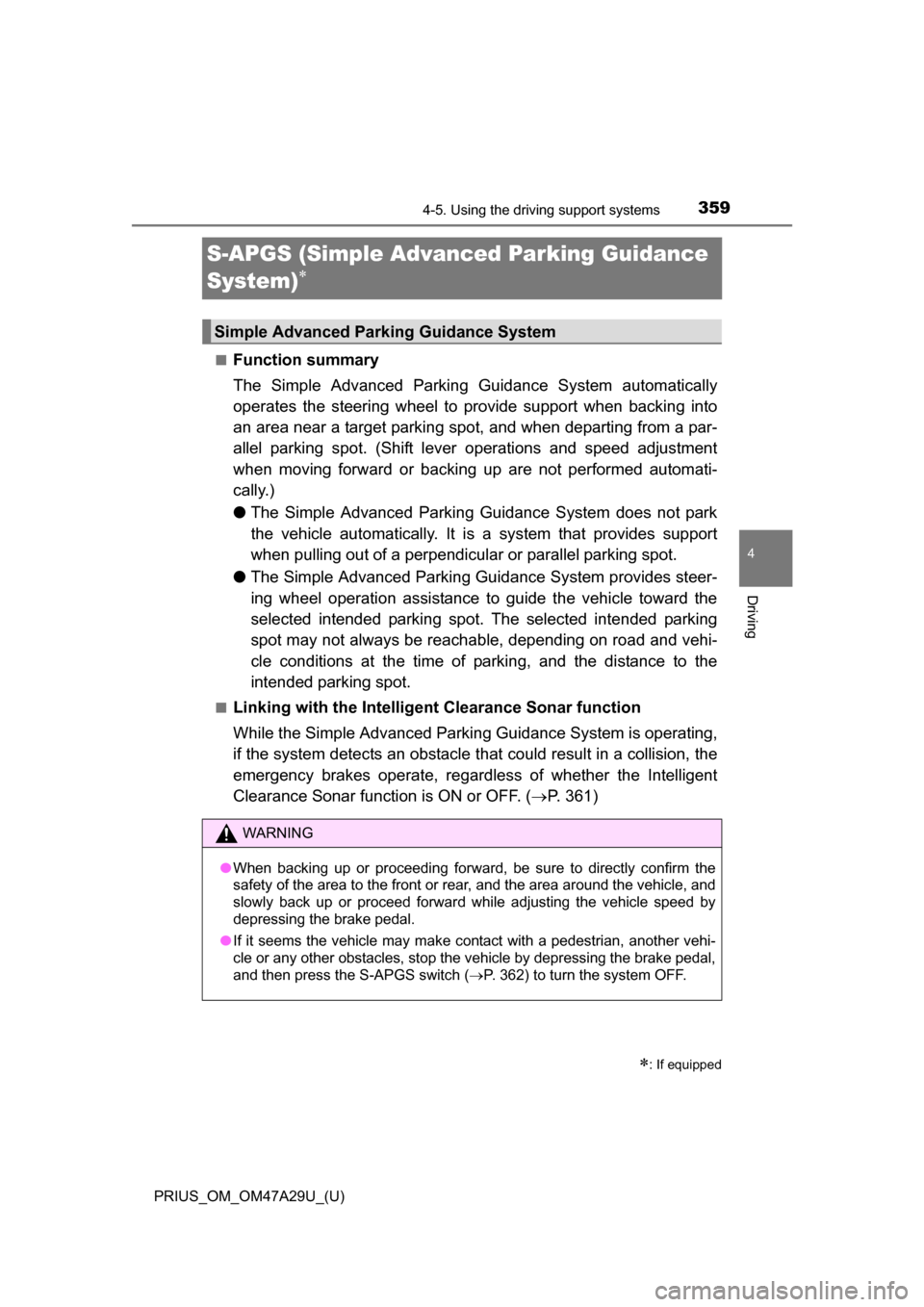
359
PRIUS_OM_OM47A29U_(U)
4-5. Using the driving support systems
4
Driving
S-APGS (Simple Adva nced Parking Guidance
System)
■Function summary
The Simple Advanced Parking Guidance System automatically
operates the steering wheel to provide support when backing into
an area near a target parking spot, and when departing from a par-
allel parking spot. (Shift lever operations and speed adjustment
when moving forward or backing up are not performed automati-
cally.)
● The Simple Advanced Parking Guidance System does not park
the vehicle automatically. It is a system that provides support
when pulling out of a perpendicular or parallel parking spot.
● The Simple Advanced Parking Gu idance System provides steer-
ing wheel operation assistance to guide the vehicle toward the
selected intended parking spot. The selected intended parking
spot may not always be reach able, depending on road and vehi-
cle conditions at the time of pa rking, and the distance to the
intended parking spot.
■Linking with the Intelligent Clearance Sonar function
While the Simple Advanced Parking Guidance System is operating,
if the system detects an obstacle t hat could result in a collision, the
emergency brakes operat e, regardless of whether the Intelligent
Clearance Sonar function is ON or OFF. ( P. 361)
: If equipped
Simple Advanced Parking Guidance System
WARNING
●When backing up or proceeding forward, be sure to directly confirm the
safety of the area to the front or rear, and the area around the vehicle, and
slowly back up or proceed forward while adjusting the vehicle speed by
depressing the brake pedal.
● If it seems the vehicle may make contact with a pedestrian, another vehi-
cle or any other obstacles, stop the vehicle by depressing the brake pedal,
and then press the S-APGS switch ( P. 362) to turn the system OFF.
Page 360 of 800
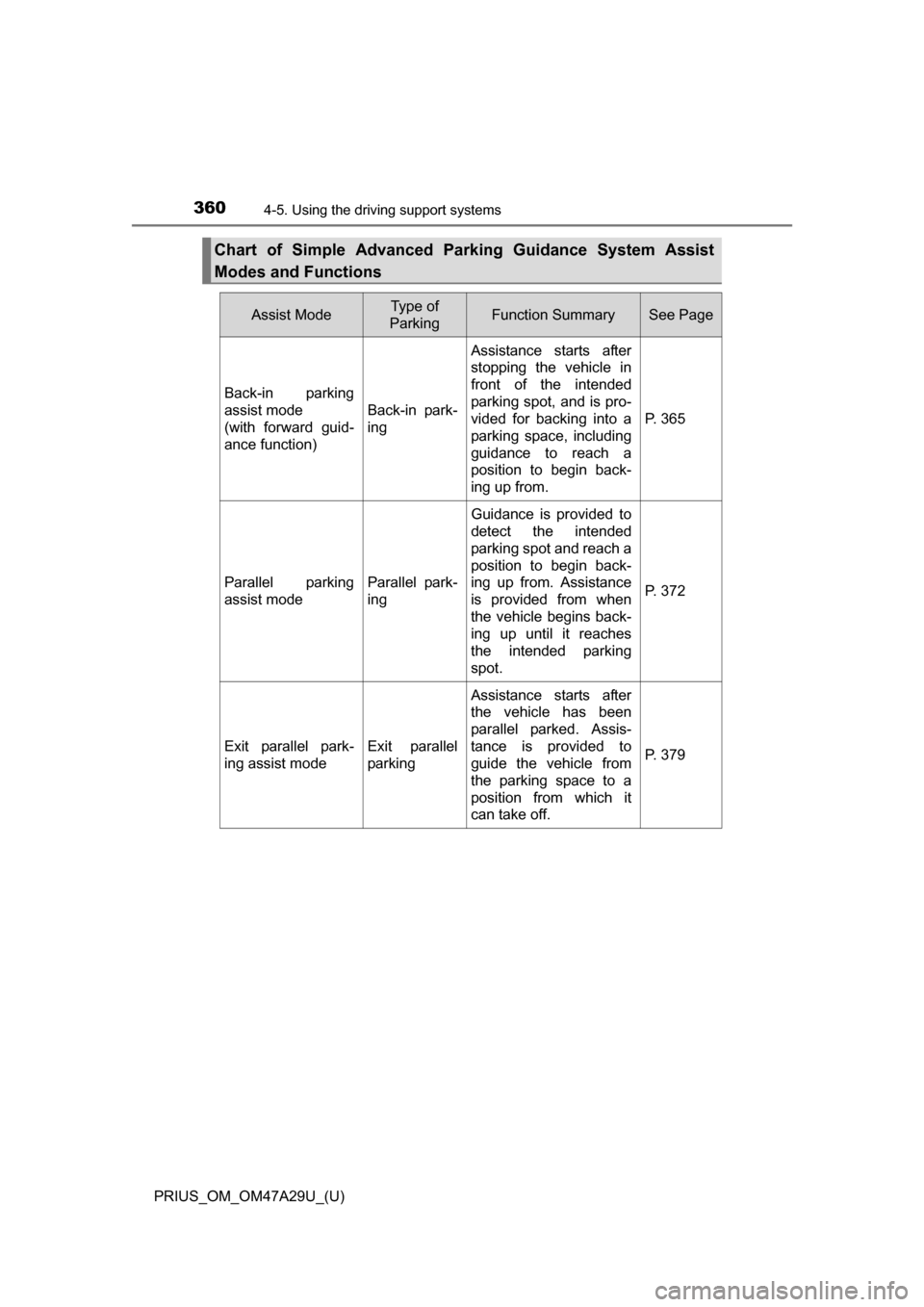
360
PRIUS_OM_OM47A29U_(U)
4-5. Using the driving support systems
Chart of Simple Advanced Parking Guidance System Assist
Modes and Functions
Assist ModeType of
ParkingFunction SummarySee Page
Back-in parking
assist mode
(with forward guid-
ance function)
Back-in park-
ing
Assistance starts after
stopping the vehicle in
front of the intended
parking spot, and is pro-
vided for backing into a
parking space, including
guidance to reach a
position to begin back-
ing up from.
P. 365
Parallel parking
assist modeParallel park-
ing
Guidance is provided to
detect the intended
parking spot and reach a
position to begin back-
ing up from. Assistance
is provided from when
the vehicle begins back-
ing up until it reaches
the intended parking
spot.
P. 372
Exit parallel park-
ing assist modeExit parallel
parking
Assistance starts after
the vehicle has been
parallel parked. Assis-
tance is provided to
guide the vehicle from
the parking space to a
position from which it
can take off.
P. 379